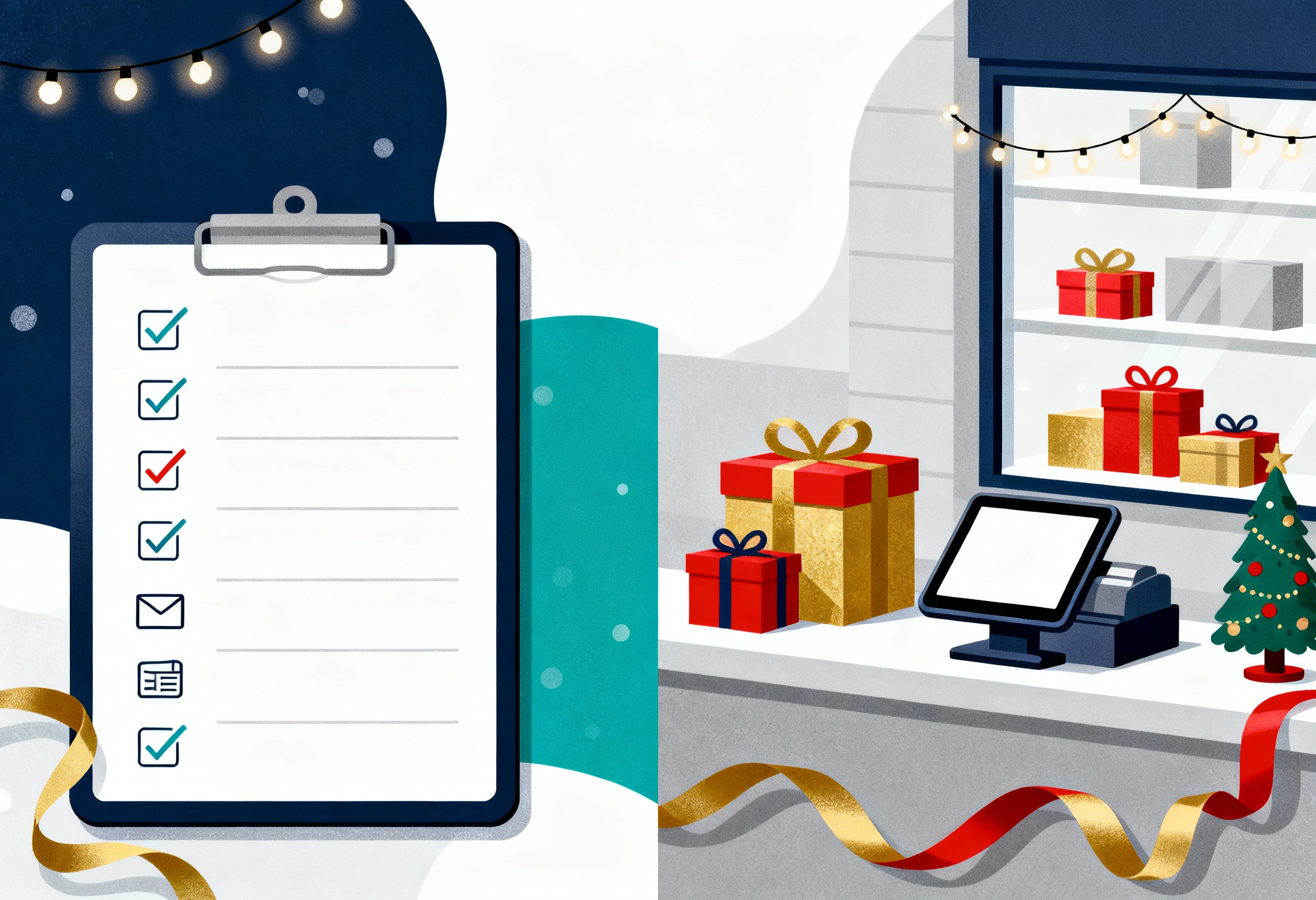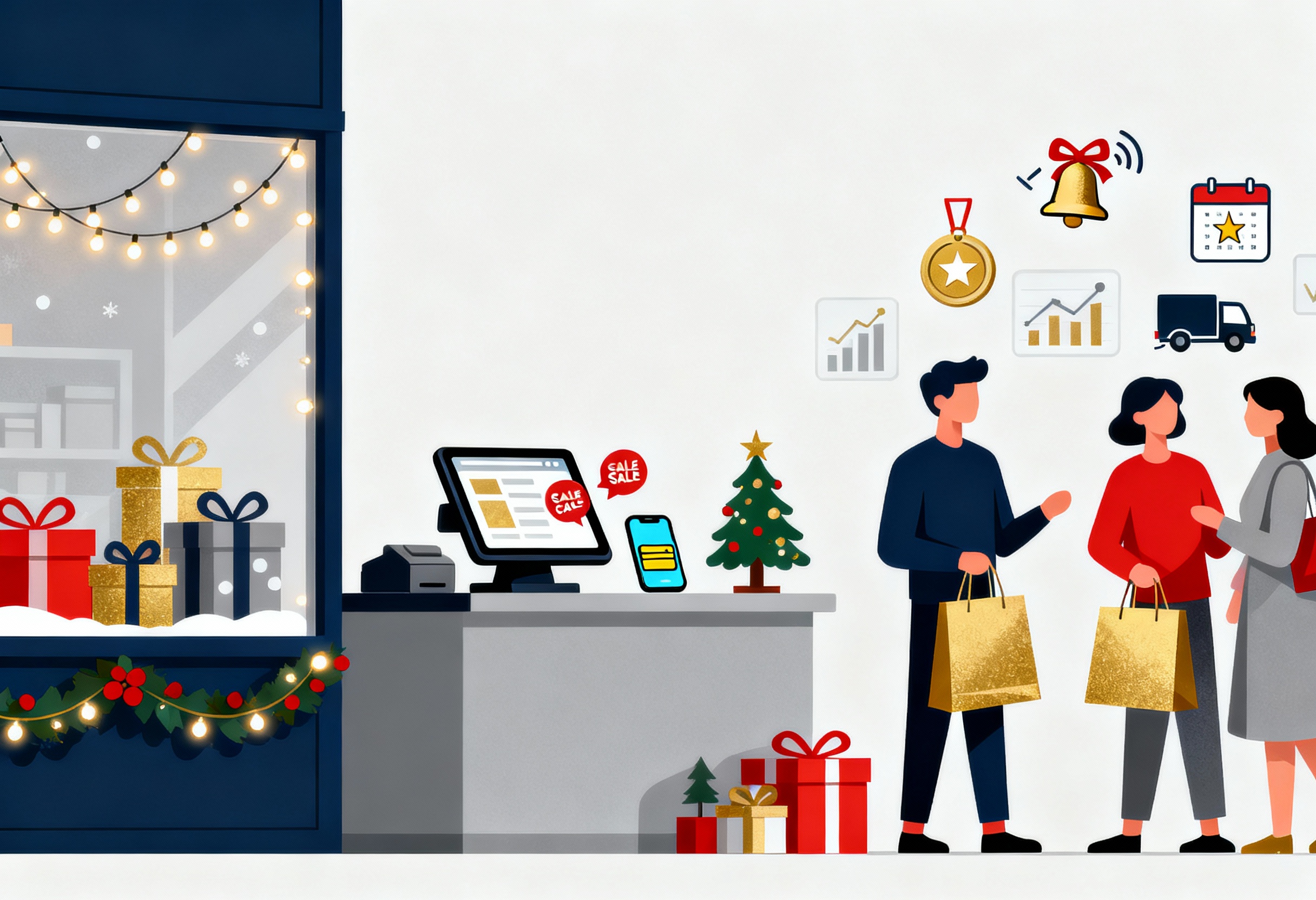The holiday window is short, and the stakes are high. Marketers are under pressure to sharpen profit strategies, strengthen brand visibility, and keep customers engaged while delivering results at speed. At the same time, the surge in promotions and campaigns makes it harder for consumers to cut through the noise. Too much choice often leads to hesitation, abandoned carts, or frustration. The challenge lies in presenting value clearly and guiding shoppers toward decisions that feel straightforward and rewarding. For teams looking to set up strong results this season, ConnectPOS has drawn on years of retail expertise to suggest a set of practical holiday retail strategies. These insights are designed to help retailers capture attention, convert intent into sales, and build momentum that lasts beyond the holiday rush.
Highlights:
- In-store exclusives and early access events give holiday shoppers a reason to visit your physical locations before the rush begins.
- Turn social engagement into revenue by connecting with holiday browsers through WhatsApp, personalized emails, and smart retargeting.
10 Proven Holiday Retail Strategies for 2025
The holiday season brings both opportunity and pressure. Consumer expectations rise, competitors run aggressive promotions, and every touchpoint matters more than usual. Retailers who prepare with a clear plan stand a better chance of attracting shoppers, driving sales, and turning seasonal buyers into long-term customers.
The following holiday retail strategies are grounded in real market shifts and retail behaviors observed across global brands. Each one is designed to help teams sharpen their focus, strengthen customer trust, and secure revenue during the busiest shopping months of the year.
Create Exclusivity for Early Shoppers
The holiday shopping window is shorter this year, yet the outlook is bright. Research shows that 27% of consumers in the US and UK plan to begin their holiday purchases as early as October. Rising inflation has encouraged many buyers to spread spending across a longer period, making October a prime time for early activity.

To capture these shoppers, retailers can design exclusive promotions for early participants. For instance, you might create special deals accessible only through your app, rewarding those who engage with your brand ahead of the peak season.
Personalize for Anonymous Visitors
When someone enters a physical store for the first time, a sales associate quickly gathers insights by asking questions, identifying preferences, and suggesting suitable products. The same approach can be applied online, even when visitors are anonymous.
Digital tools make it possible to track browsing patterns, entry points, cart activity, and time spent on different pages. This data allows brands to create tailored shopping journeys.
Product suggestions, targeted push notifications, and dynamic discounts can all be triggered by shopper behavior, turning an anonymous click into a more meaningful interaction. Personalization remains one of the most effective holiday retail strategies for increasing revenue during the peak season.
Turn One-Time Buyers into Repeat Spenders
The number of shopping days between Thanksgiving and Christmas matters less if you can encourage a one-time buyer to return to the cart for more. Every additional item sold adds to revenue, no matter when it happens.
To make this happen, shoppers landing on your holiday channels should encounter prompts that nudge them toward extra purchases. That can include personalized product suggestions like recommending socks when someone buys shoes. Holiday bundles can also work well, combining products into gift-ready sets at attractive rates.
►►► Optimal solution set for businesses: Multi store POS, Next-gen POS, Inventory Management Software (MSI), Self Service, Automation, Backorders
Another proven method is progress bars, showing shoppers how close they are to unlocking special discounts or rewards as they add items. This approach mirrors in-store upselling and has become a staple in many successful holiday retail strategies.
Convert Social Media Engagement
Forbes reports 59% of consumers admitted they discover new products unintentionally while scrolling through social media.
Social platforms remain a crowded space where shoppers spend over 2.5 hours per day, and a third of them use these platforms to discover new products. This makes social media one of the most direct paths to spark interest and turn attention into purchases.
The key is moving casual scrollers into direct conversations. On Instagram, for example, engaging ads can guide users into direct messages or WhatsApp, where brands can continue the dialogue. From that point, personalized recommendations, tailored discounts, and quick answers keep the interaction active.
The same can be done with Facebook ads, driving users to WhatsApp, then nurturing them with targeted promotions, reminders, and deals once they opt in. This creates a continuous loop between social media presence and sales activity.
Drive Urgency with FOMO
FOMO (fear of missing out) may not be a clinical term, but it reflects a powerful motivator in consumer psychology. When shoppers believe they might miss out on a deal or a product, they tend to make quicker decisions.
As part of effective holiday retail strategies, countdown timers in emails or landing pages highlight how little time remains, while stock notifications remind buyers that availability is shrinking. Holiday wishlist reminders work in the same way, drawing attention to items tied to limited-time discounts.
When used strategically, urgency reshapes the buying journey. It shifts hesitation into action and creates momentum during the holiday rush. Customers feel the need to commit before the chance disappears, and brands benefit from stronger conversions within a shorter time frame. The art lies in applying just enough pressure to spark action without overwhelming the shopper, turning urgency into a driver of both sales and loyalty.
Simplify Product Discovery
Shoppers often move across devices and channels before deciding what to buy, and a cluttered catalog can quickly create friction. If a buyer has to scroll through endless products, chances are they will abandon their cart and head elsewhere.
One way to prevent this is by creating curated collections that match customer needs, such as “Gifts Under $50,” “Best Sellers in Electronics,” or “Holiday Picks for Kids.” These focused groupings cut through the noise and give customers an immediate sense of direction. Smarter tools, like predictive search that suggests relevant products as shoppers type, or filters that allow them to sort by price, color, or style, further reduce frustration.
On-the-go shoppers want shortcuts. To make every click valuable, streamline discovery with features like trending products on the homepage, AI-driven recommendations, and curated “shop the look” bundles. These tools simplify the shopping journey, keeping customers engaged. Approaches like these are central to effective holiday retail strategies, ensuring that shoppers find what they want quickly and stay motivated to complete their purchases.
Re-Engage Abandoned Shoppers
A key component of successful holiday retail strategies is knowing how to re-engage customers who leave your site without completing a purchase. The relationship doesn’t have to end there. If you’ve already collected their email address, phone number, or connected with them through your app, you have a valuable opportunity to bring them back and convert that lost sale.
Re-engagement can take many forms. Price alerts for products they viewed remind them that the item they wanted is now more affordable. Restock notifications inform them when unavailable products are back, making it easy for them to act quickly without searching elsewhere.
Cart or browse reminders serve as a gentle prompt, encouraging them to complete what they started. If these tactics don’t lead to a conversion, sweetening the deal with free delivery, early access to upcoming sales, or a small gift can tip the scales in your favor.
Build Post-Purchase Trust
The customer journey does not stop when payment is complete. Trust grows through clear communication and thoughtful follow-up, which are crucial holiday retail strategies. Personalized confirmations sent through email, SMS, or WhatsApp include order details and timely updates that reassure buyers they made the right choice. Messages that thank customers and provide easy access to support create a smoother experience.
Post-purchase engagement can go further. Sharing product care guidance, sending surveys, or providing loyalty incentives shows that the relationship extends beyond a single transaction.
Using a mix of channels such as email, SMS, and WhatsApp keeps communication fresh and direct, helping retailers stay present in customers’ minds and laying the groundwork for repeat purchases.
Gamify Email And SMS Sign-Ups
During the holiday rush, stores compete for attention with discounts, special bundles, and aggressive marketing campaigns. Shoppers often browse across many sites before deciding, so brands that fail to gather contact details lose the chance to reconnect. For example, if a visitor leaves your site after browsing gifts without signing up, you may never reach them again when new stock arrives. Collecting leads early gives you a direct line to those who already showed interest.
One practical way is to place a “Wheel of Fortune” on the site that rewards customers for sharing their email or phone number. Shoppers can spin the wheel to unlock a 10% discount, free shipping, or a chance to enter a holiday giveaway. This creates a playful moment that feels less like a form-filling task and more like part of the shopping experience. Brands often see higher sign-up rates because the activity is interactive, and shoppers feel they are getting immediate value.
Make Conversions Easy through WhatsApp
When shoppers discover new products during the holiday season, they often want quick answers. Integrating WhatsApp into holiday retail strategies shortens the shopping journeyWhatsApp can handle this by acting as both a product catalog and a checkout point.
For example, a shopper browsing for sneakers can open a catalog within WhatsApp, review different models, ask about size availability, and add a pair to the cart without switching to a website. This shortens the journey from browsing to purchase, which is especially important when customers are busy.
Two-way conversations add another layer. A customer might ask, “Does this come in red?” and receive a quick response along with a link to buy directly. Brands can also send order confirmations, delivery updates, or re
Power Your Holiday Sales with ConnectPOS
The holiday season is the most demanding time of the year for retailers. High traffic, short decision-making cycles, and complex customer expectations require a system that supports both online and offline transactions without friction. ConnectPOS is designed for holiday retail strategies to help retailers maintain control, create meaningful customer experiences, and drive sales during the busiest shopping weeks.
Key capabilities of ConnectPOS that support holiday growth:
- Unified shopping journey across channels: Shoppers can use an omnichannel POS system to browse online, reserve items, and complete purchases in-store without losing continuity. A parent buying gifts online, for example, can pick up the order at a nearby store while adding another item on the spot.
- Real-time inventory accuracy: Every sale, return, or stock transfer is updated instantly across warehouses and stores. This prevents overselling, reduces out-of-stock disappointments, and keeps customer trust intact during peak days.
- Mobile point of sale flexibility: Sales staff can carry tablets to process payments anywhere on the shop floor. During crowded weekends, this helps serve more customers quickly and keeps queues under control.
- Personalized promotions and loyalty programs: Retailers can tailor discounts or reward points to specific groups. For instance, returning customers may receive early access to limited products, encouraging repeat purchases.
- Comprehensive reporting and analytics: Decision-makers get real-time visibility into bestsellers, underperforming products, and staff performance. This reporting and analytics clarity supports rapid adjustments, such as increasing stock of trending items or reassigning sales teams.
- Omnichannel payment support: ConnectPOS accepts a wide range of payment methods, from credit cards to digital wallets and even gift cards. During the holiday rush, a family shopping together can split payments across cash and e-wallets without slowing down the checkout.
- Customizable receipts and post-sale communication: Receipts can include promotions, loyalty reminders, or care instructions tailored to the purchase. A customer buying electronics, for example, can receive warranty details and a QR code linking to product tutorials, extending engagement beyond the transaction.
FAQs: Holiday Retail Strategies
Why should retailers prepare their holiday retail strategies months in advance months in advance?
Because consumer behavior shifts quickly during the holiday period, waiting until the last minute can leave gaps in inventory planning, staff allocation, and marketing execution. Early preparation allows brands to anticipate demand, negotiate better supplier terms, and test technology setups before traffic peaks.
What role does inventory planning play in holiday success?
Holiday campaigns attract larger traffic spikes than other times of the year. Without precise stock forecasting and restock alerts, retailers risk lost sales or overstocking. A well-structured plan ensures the right mix of products is available at the right time.
How do promotions and discounts influence buying behavior during the season?
Seasonal shoppers are price-sensitive but also value exclusivity. Limited-time bundles, early access deals, and personalized promotions not only spark urgency but also keep buyers engaged beyond one-time transactions.
Can technology really make a difference in holiday conversions?
Yes. Tools like ConnectPOS, real-time analytics, and mobile payment options directly influence how fast and smooth the buying process feels. A retailer running multiple sales channels can use unified systems to maintain accurate stock counts and prevent overselling.
Conclusion
Holiday retail success comes down to clarity, timing, and execution. With suitable holiday retail strategies, brands can guide shoppers with confidence, remove friction at the point of purchase, and build trust after checkout will capture more than short-term revenue; they will create relationships that extend into the new year. While the competition will be loud, those who focus on smart planning and customer-first experiences will stand out.
ConnectPOS helps retailers turn these strategies into measurable outcomes. From real-time inventory tracking to smarter promotions and mobile-first engagement, our solutions give your team the tools to act quickly and sell effectively when it matters most.
Ready to power your holiday sales? Get in touch with ConnectPOS today and see how we can help you capture every opportunity this season.
►►► Optimal solution set for businesses: Shopify POS, Magento POS, BigCommerce POS, WooCommerce POS, NetSuite POS, E-Commerce POS



